COMP40321: Analyzing Technology's Role in Oil Company Decisions
VerifiedAdded on 2023/06/11
|26
|7836
|165
Report
AI Summary
This report explores the role of technology in improving decision-making processes within oil companies, particularly in the Arabian Peninsula. It begins by highlighting the historical context of technological innovation in the oil industry, starting with Edwin L. Drake's early advancements. The report then discusses the increasing integration of the Internet of Things (IoT) and its impact on productivity, cost reduction, and efficiency. It addresses the problem of effectively adopting and adapting new technologies in the oil sector, especially in developing countries like those in the Arabian Peninsula, where technology transfer faces challenges such as a lack of skilled manpower. The research objectives include determining technology's role in decision-making, identifying current technologies in the oil sector, and understanding factors affecting technological adaptation. The literature review covers technology transfer, its phases (assessment, selection, adaptation, utilization, and expansion), and issues related to technology transfer, such as the need for skilled manpower and a focus beyond mere production. Finally, the report touches on the application of robotics in the oil sector, detailing the various components and functions of robots used in the industry. Desklib provides similar solved assignments and resources for students.
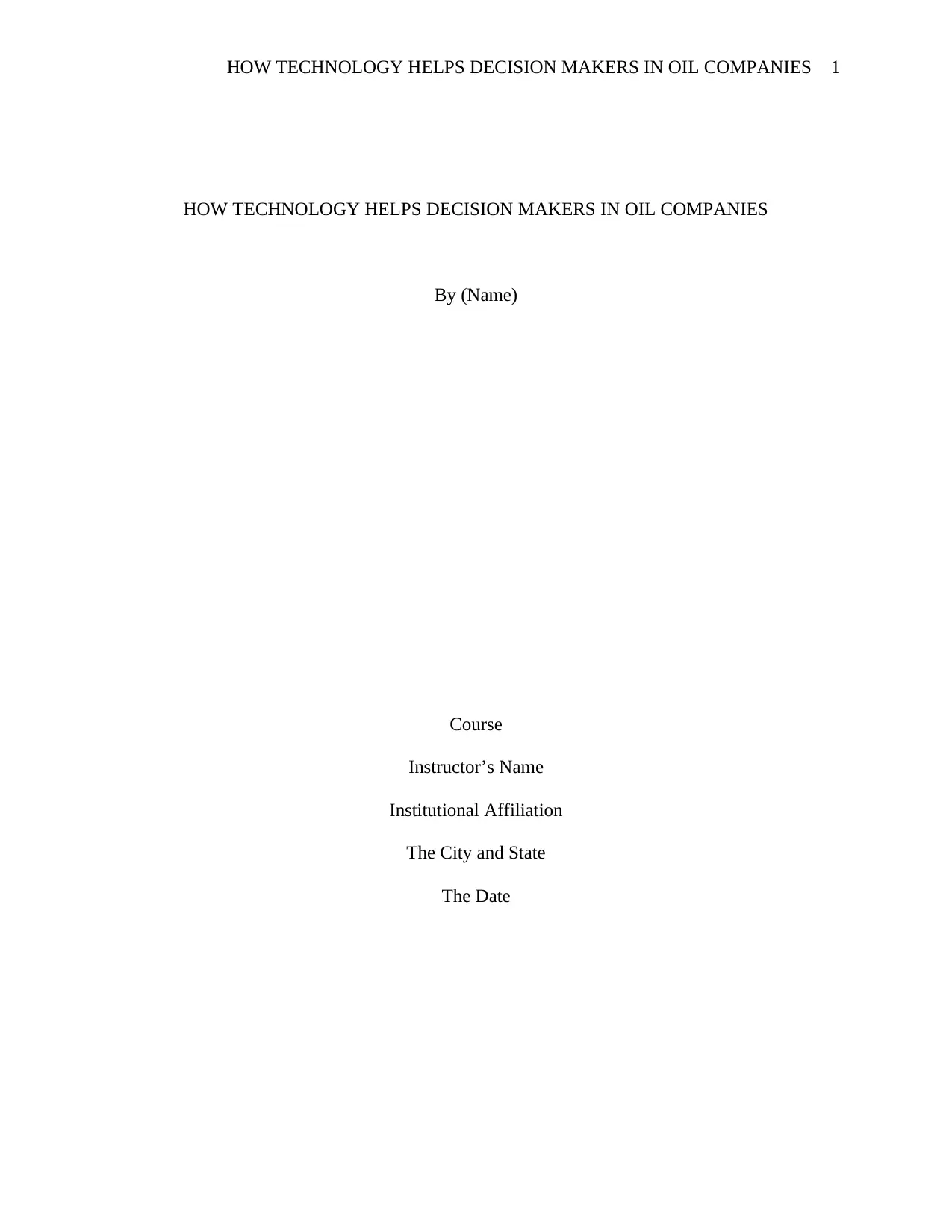
HOW TECHNOLOGY HELPS DECISION MAKERS IN OIL COMPANIES 1
HOW TECHNOLOGY HELPS DECISION MAKERS IN OIL COMPANIES
By (Name)
Course
Instructor’s Name
Institutional Affiliation
The City and State
The Date
HOW TECHNOLOGY HELPS DECISION MAKERS IN OIL COMPANIES
By (Name)
Course
Instructor’s Name
Institutional Affiliation
The City and State
The Date
Paraphrase This Document
Need a fresh take? Get an instant paraphrase of this document with our AI Paraphraser
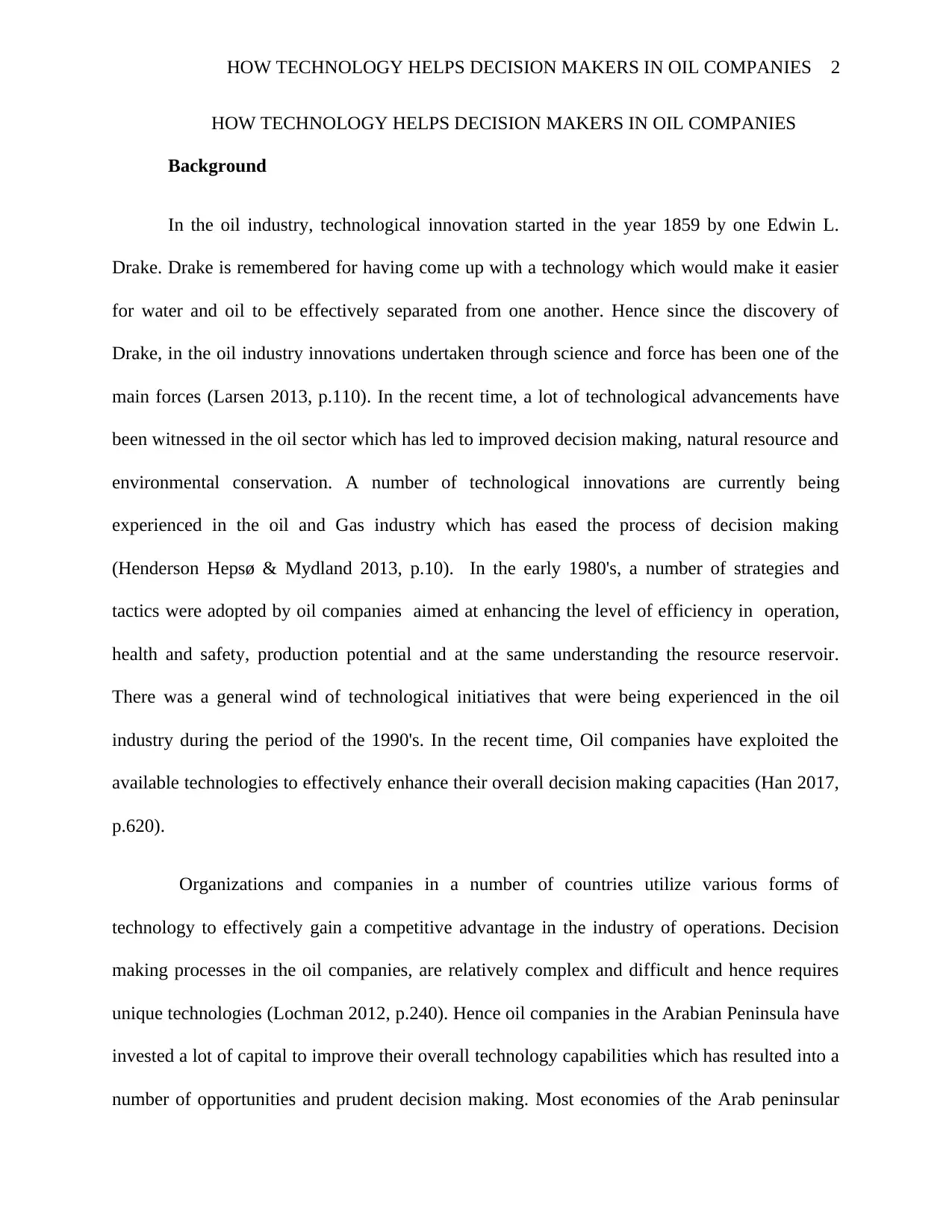
HOW TECHNOLOGY HELPS DECISION MAKERS IN OIL COMPANIES 2
HOW TECHNOLOGY HELPS DECISION MAKERS IN OIL COMPANIES
Background
In the oil industry, technological innovation started in the year 1859 by one Edwin L.
Drake. Drake is remembered for having come up with a technology which would make it easier
for water and oil to be effectively separated from one another. Hence since the discovery of
Drake, in the oil industry innovations undertaken through science and force has been one of the
main forces (Larsen 2013, p.110). In the recent time, a lot of technological advancements have
been witnessed in the oil sector which has led to improved decision making, natural resource and
environmental conservation. A number of technological innovations are currently being
experienced in the oil and Gas industry which has eased the process of decision making
(Henderson Hepsø & Mydland 2013, p.10). In the early 1980's, a number of strategies and
tactics were adopted by oil companies aimed at enhancing the level of efficiency in operation,
health and safety, production potential and at the same understanding the resource reservoir.
There was a general wind of technological initiatives that were being experienced in the oil
industry during the period of the 1990's. In the recent time, Oil companies have exploited the
available technologies to effectively enhance their overall decision making capacities (Han 2017,
p.620).
Organizations and companies in a number of countries utilize various forms of
technology to effectively gain a competitive advantage in the industry of operations. Decision
making processes in the oil companies, are relatively complex and difficult and hence requires
unique technologies (Lochman 2012, p.240). Hence oil companies in the Arabian Peninsula have
invested a lot of capital to improve their overall technology capabilities which has resulted into a
number of opportunities and prudent decision making. Most economies of the Arab peninsular
HOW TECHNOLOGY HELPS DECISION MAKERS IN OIL COMPANIES
Background
In the oil industry, technological innovation started in the year 1859 by one Edwin L.
Drake. Drake is remembered for having come up with a technology which would make it easier
for water and oil to be effectively separated from one another. Hence since the discovery of
Drake, in the oil industry innovations undertaken through science and force has been one of the
main forces (Larsen 2013, p.110). In the recent time, a lot of technological advancements have
been witnessed in the oil sector which has led to improved decision making, natural resource and
environmental conservation. A number of technological innovations are currently being
experienced in the oil and Gas industry which has eased the process of decision making
(Henderson Hepsø & Mydland 2013, p.10). In the early 1980's, a number of strategies and
tactics were adopted by oil companies aimed at enhancing the level of efficiency in operation,
health and safety, production potential and at the same understanding the resource reservoir.
There was a general wind of technological initiatives that were being experienced in the oil
industry during the period of the 1990's. In the recent time, Oil companies have exploited the
available technologies to effectively enhance their overall decision making capacities (Han 2017,
p.620).
Organizations and companies in a number of countries utilize various forms of
technology to effectively gain a competitive advantage in the industry of operations. Decision
making processes in the oil companies, are relatively complex and difficult and hence requires
unique technologies (Lochman 2012, p.240). Hence oil companies in the Arabian Peninsula have
invested a lot of capital to improve their overall technology capabilities which has resulted into a
number of opportunities and prudent decision making. Most economies of the Arab peninsular
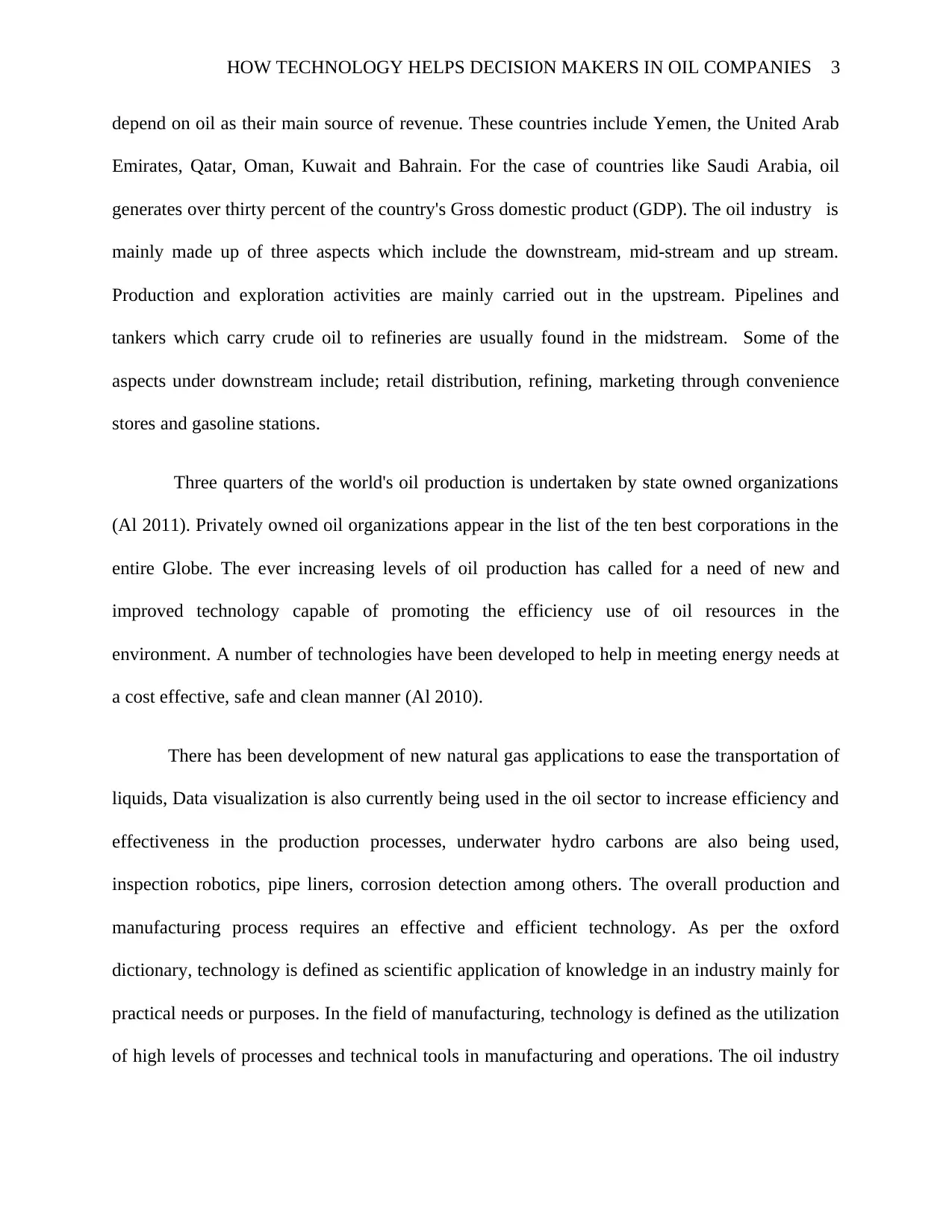
HOW TECHNOLOGY HELPS DECISION MAKERS IN OIL COMPANIES 3
depend on oil as their main source of revenue. These countries include Yemen, the United Arab
Emirates, Qatar, Oman, Kuwait and Bahrain. For the case of countries like Saudi Arabia, oil
generates over thirty percent of the country's Gross domestic product (GDP). The oil industry is
mainly made up of three aspects which include the downstream, mid-stream and up stream.
Production and exploration activities are mainly carried out in the upstream. Pipelines and
tankers which carry crude oil to refineries are usually found in the midstream. Some of the
aspects under downstream include; retail distribution, refining, marketing through convenience
stores and gasoline stations.
Three quarters of the world's oil production is undertaken by state owned organizations
(Al 2011). Privately owned oil organizations appear in the list of the ten best corporations in the
entire Globe. The ever increasing levels of oil production has called for a need of new and
improved technology capable of promoting the efficiency use of oil resources in the
environment. A number of technologies have been developed to help in meeting energy needs at
a cost effective, safe and clean manner (Al 2010).
There has been development of new natural gas applications to ease the transportation of
liquids, Data visualization is also currently being used in the oil sector to increase efficiency and
effectiveness in the production processes, underwater hydro carbons are also being used,
inspection robotics, pipe liners, corrosion detection among others. The overall production and
manufacturing process requires an effective and efficient technology. As per the oxford
dictionary, technology is defined as scientific application of knowledge in an industry mainly for
practical needs or purposes. In the field of manufacturing, technology is defined as the utilization
of high levels of processes and technical tools in manufacturing and operations. The oil industry
depend on oil as their main source of revenue. These countries include Yemen, the United Arab
Emirates, Qatar, Oman, Kuwait and Bahrain. For the case of countries like Saudi Arabia, oil
generates over thirty percent of the country's Gross domestic product (GDP). The oil industry is
mainly made up of three aspects which include the downstream, mid-stream and up stream.
Production and exploration activities are mainly carried out in the upstream. Pipelines and
tankers which carry crude oil to refineries are usually found in the midstream. Some of the
aspects under downstream include; retail distribution, refining, marketing through convenience
stores and gasoline stations.
Three quarters of the world's oil production is undertaken by state owned organizations
(Al 2011). Privately owned oil organizations appear in the list of the ten best corporations in the
entire Globe. The ever increasing levels of oil production has called for a need of new and
improved technology capable of promoting the efficiency use of oil resources in the
environment. A number of technologies have been developed to help in meeting energy needs at
a cost effective, safe and clean manner (Al 2010).
There has been development of new natural gas applications to ease the transportation of
liquids, Data visualization is also currently being used in the oil sector to increase efficiency and
effectiveness in the production processes, underwater hydro carbons are also being used,
inspection robotics, pipe liners, corrosion detection among others. The overall production and
manufacturing process requires an effective and efficient technology. As per the oxford
dictionary, technology is defined as scientific application of knowledge in an industry mainly for
practical needs or purposes. In the field of manufacturing, technology is defined as the utilization
of high levels of processes and technical tools in manufacturing and operations. The oil industry
⊘ This is a preview!⊘
Do you want full access?
Subscribe today to unlock all pages.

Trusted by 1+ million students worldwide
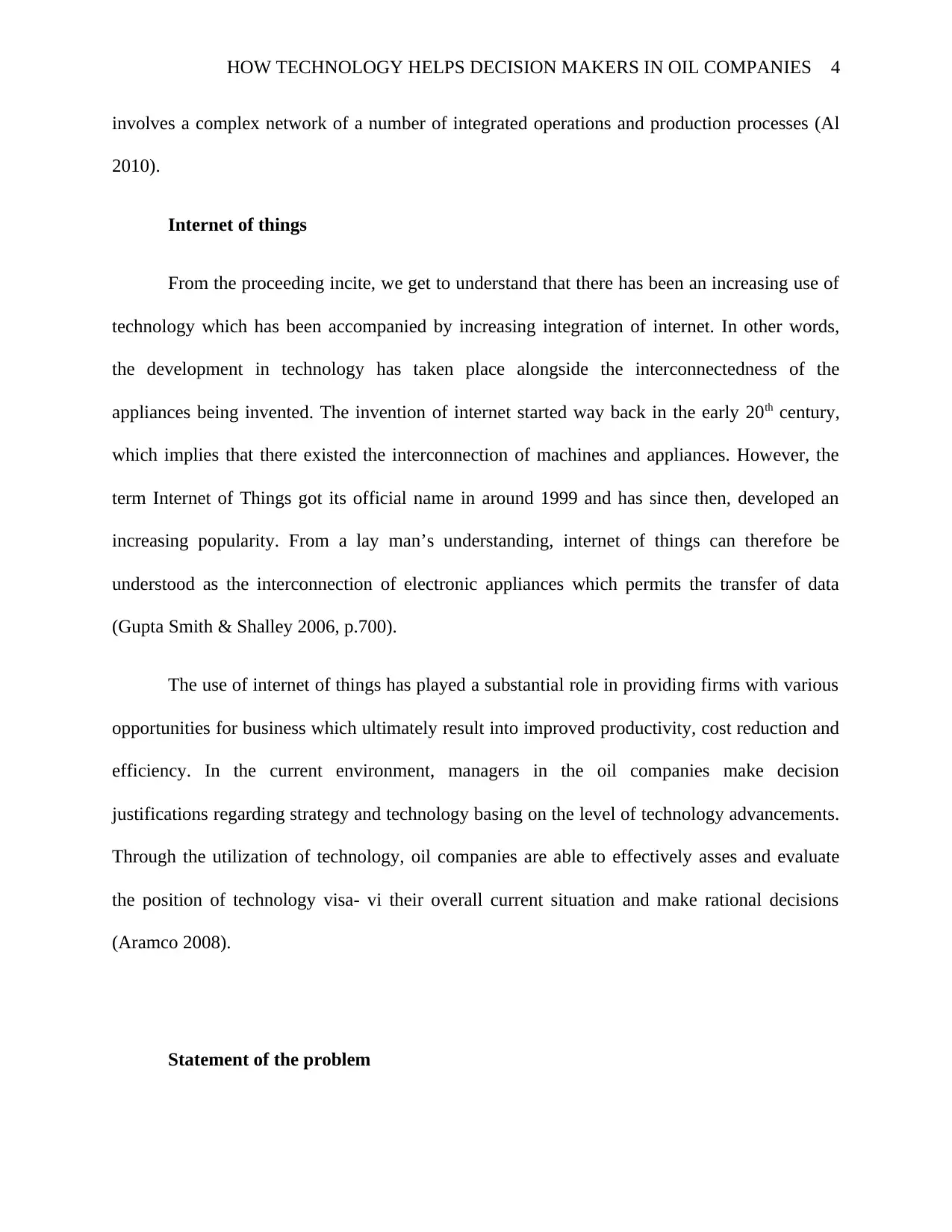
HOW TECHNOLOGY HELPS DECISION MAKERS IN OIL COMPANIES 4
involves a complex network of a number of integrated operations and production processes (Al
2010).
Internet of things
From the proceeding incite, we get to understand that there has been an increasing use of
technology which has been accompanied by increasing integration of internet. In other words,
the development in technology has taken place alongside the interconnectedness of the
appliances being invented. The invention of internet started way back in the early 20th century,
which implies that there existed the interconnection of machines and appliances. However, the
term Internet of Things got its official name in around 1999 and has since then, developed an
increasing popularity. From a lay man’s understanding, internet of things can therefore be
understood as the interconnection of electronic appliances which permits the transfer of data
(Gupta Smith & Shalley 2006, p.700).
The use of internet of things has played a substantial role in providing firms with various
opportunities for business which ultimately result into improved productivity, cost reduction and
efficiency. In the current environment, managers in the oil companies make decision
justifications regarding strategy and technology basing on the level of technology advancements.
Through the utilization of technology, oil companies are able to effectively asses and evaluate
the position of technology visa- vi their overall current situation and make rational decisions
(Aramco 2008).
Statement of the problem
involves a complex network of a number of integrated operations and production processes (Al
2010).
Internet of things
From the proceeding incite, we get to understand that there has been an increasing use of
technology which has been accompanied by increasing integration of internet. In other words,
the development in technology has taken place alongside the interconnectedness of the
appliances being invented. The invention of internet started way back in the early 20th century,
which implies that there existed the interconnection of machines and appliances. However, the
term Internet of Things got its official name in around 1999 and has since then, developed an
increasing popularity. From a lay man’s understanding, internet of things can therefore be
understood as the interconnection of electronic appliances which permits the transfer of data
(Gupta Smith & Shalley 2006, p.700).
The use of internet of things has played a substantial role in providing firms with various
opportunities for business which ultimately result into improved productivity, cost reduction and
efficiency. In the current environment, managers in the oil companies make decision
justifications regarding strategy and technology basing on the level of technology advancements.
Through the utilization of technology, oil companies are able to effectively asses and evaluate
the position of technology visa- vi their overall current situation and make rational decisions
(Aramco 2008).
Statement of the problem
Paraphrase This Document
Need a fresh take? Get an instant paraphrase of this document with our AI Paraphraser
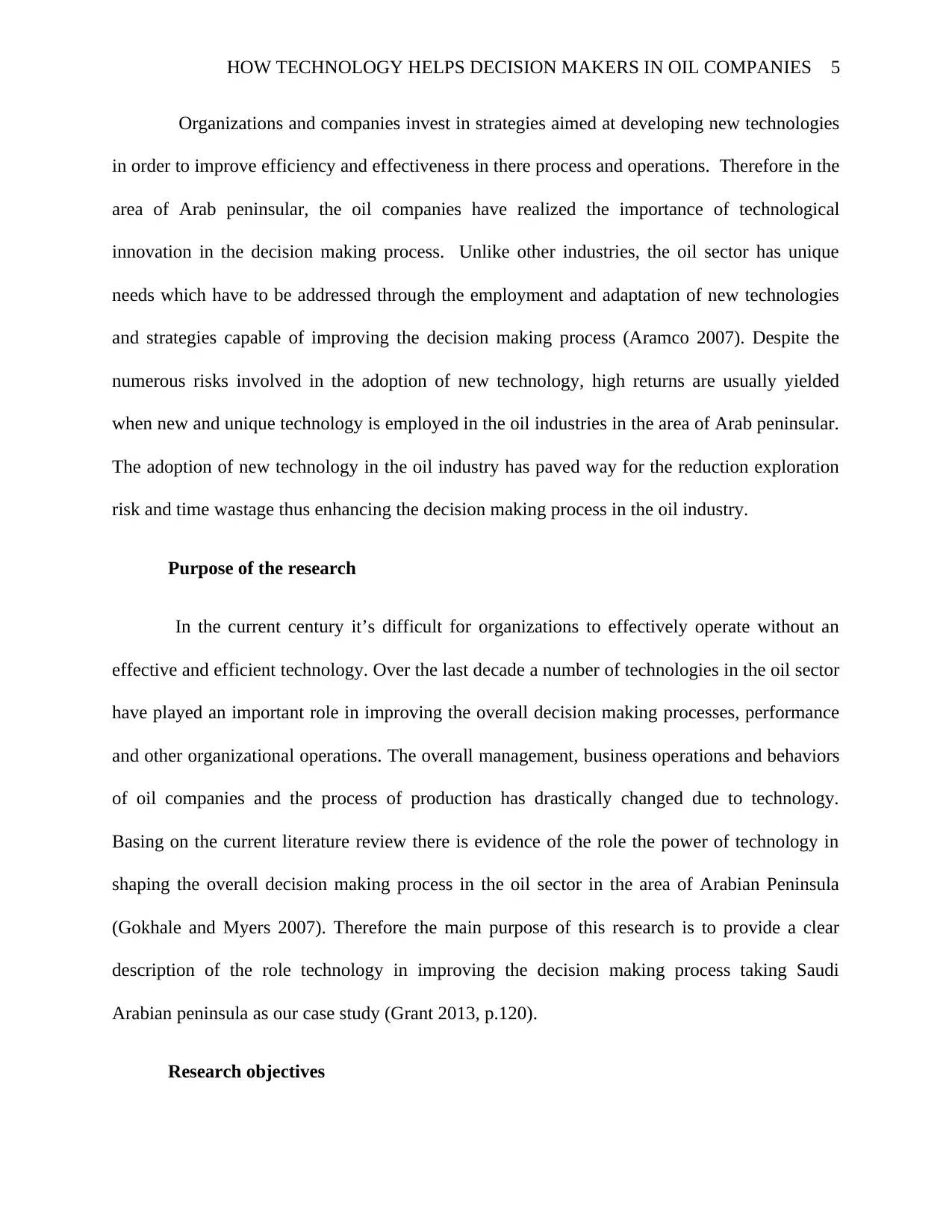
HOW TECHNOLOGY HELPS DECISION MAKERS IN OIL COMPANIES 5
Organizations and companies invest in strategies aimed at developing new technologies
in order to improve efficiency and effectiveness in there process and operations. Therefore in the
area of Arab peninsular, the oil companies have realized the importance of technological
innovation in the decision making process. Unlike other industries, the oil sector has unique
needs which have to be addressed through the employment and adaptation of new technologies
and strategies capable of improving the decision making process (Aramco 2007). Despite the
numerous risks involved in the adoption of new technology, high returns are usually yielded
when new and unique technology is employed in the oil industries in the area of Arab peninsular.
The adoption of new technology in the oil industry has paved way for the reduction exploration
risk and time wastage thus enhancing the decision making process in the oil industry.
Purpose of the research
In the current century it’s difficult for organizations to effectively operate without an
effective and efficient technology. Over the last decade a number of technologies in the oil sector
have played an important role in improving the overall decision making processes, performance
and other organizational operations. The overall management, business operations and behaviors
of oil companies and the process of production has drastically changed due to technology.
Basing on the current literature review there is evidence of the role the power of technology in
shaping the overall decision making process in the oil sector in the area of Arabian Peninsula
(Gokhale and Myers 2007). Therefore the main purpose of this research is to provide a clear
description of the role technology in improving the decision making process taking Saudi
Arabian peninsula as our case study (Grant 2013, p.120).
Research objectives
Organizations and companies invest in strategies aimed at developing new technologies
in order to improve efficiency and effectiveness in there process and operations. Therefore in the
area of Arab peninsular, the oil companies have realized the importance of technological
innovation in the decision making process. Unlike other industries, the oil sector has unique
needs which have to be addressed through the employment and adaptation of new technologies
and strategies capable of improving the decision making process (Aramco 2007). Despite the
numerous risks involved in the adoption of new technology, high returns are usually yielded
when new and unique technology is employed in the oil industries in the area of Arab peninsular.
The adoption of new technology in the oil industry has paved way for the reduction exploration
risk and time wastage thus enhancing the decision making process in the oil industry.
Purpose of the research
In the current century it’s difficult for organizations to effectively operate without an
effective and efficient technology. Over the last decade a number of technologies in the oil sector
have played an important role in improving the overall decision making processes, performance
and other organizational operations. The overall management, business operations and behaviors
of oil companies and the process of production has drastically changed due to technology.
Basing on the current literature review there is evidence of the role the power of technology in
shaping the overall decision making process in the oil sector in the area of Arabian Peninsula
(Gokhale and Myers 2007). Therefore the main purpose of this research is to provide a clear
description of the role technology in improving the decision making process taking Saudi
Arabian peninsula as our case study (Grant 2013, p.120).
Research objectives
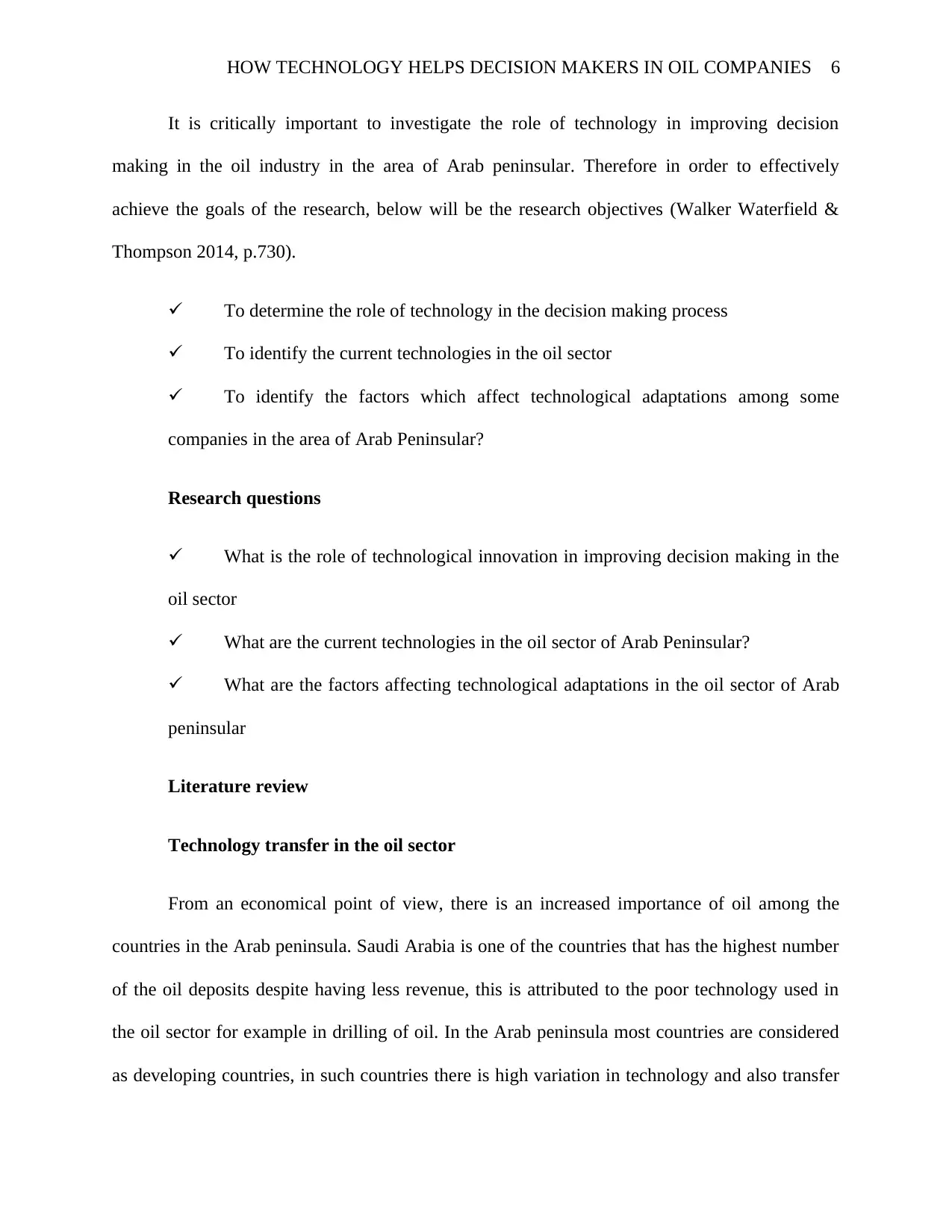
HOW TECHNOLOGY HELPS DECISION MAKERS IN OIL COMPANIES 6
It is critically important to investigate the role of technology in improving decision
making in the oil industry in the area of Arab peninsular. Therefore in order to effectively
achieve the goals of the research, below will be the research objectives (Walker Waterfield &
Thompson 2014, p.730).
To determine the role of technology in the decision making process
To identify the current technologies in the oil sector
To identify the factors which affect technological adaptations among some
companies in the area of Arab Peninsular?
Research questions
What is the role of technological innovation in improving decision making in the
oil sector
What are the current technologies in the oil sector of Arab Peninsular?
What are the factors affecting technological adaptations in the oil sector of Arab
peninsular
Literature review
Technology transfer in the oil sector
From an economical point of view, there is an increased importance of oil among the
countries in the Arab peninsula. Saudi Arabia is one of the countries that has the highest number
of the oil deposits despite having less revenue, this is attributed to the poor technology used in
the oil sector for example in drilling of oil. In the Arab peninsula most countries are considered
as developing countries, in such countries there is high variation in technology and also transfer
It is critically important to investigate the role of technology in improving decision
making in the oil industry in the area of Arab peninsular. Therefore in order to effectively
achieve the goals of the research, below will be the research objectives (Walker Waterfield &
Thompson 2014, p.730).
To determine the role of technology in the decision making process
To identify the current technologies in the oil sector
To identify the factors which affect technological adaptations among some
companies in the area of Arab Peninsular?
Research questions
What is the role of technological innovation in improving decision making in the
oil sector
What are the current technologies in the oil sector of Arab Peninsular?
What are the factors affecting technological adaptations in the oil sector of Arab
peninsular
Literature review
Technology transfer in the oil sector
From an economical point of view, there is an increased importance of oil among the
countries in the Arab peninsula. Saudi Arabia is one of the countries that has the highest number
of the oil deposits despite having less revenue, this is attributed to the poor technology used in
the oil sector for example in drilling of oil. In the Arab peninsula most countries are considered
as developing countries, in such countries there is high variation in technology and also transfer
⊘ This is a preview!⊘
Do you want full access?
Subscribe today to unlock all pages.

Trusted by 1+ million students worldwide
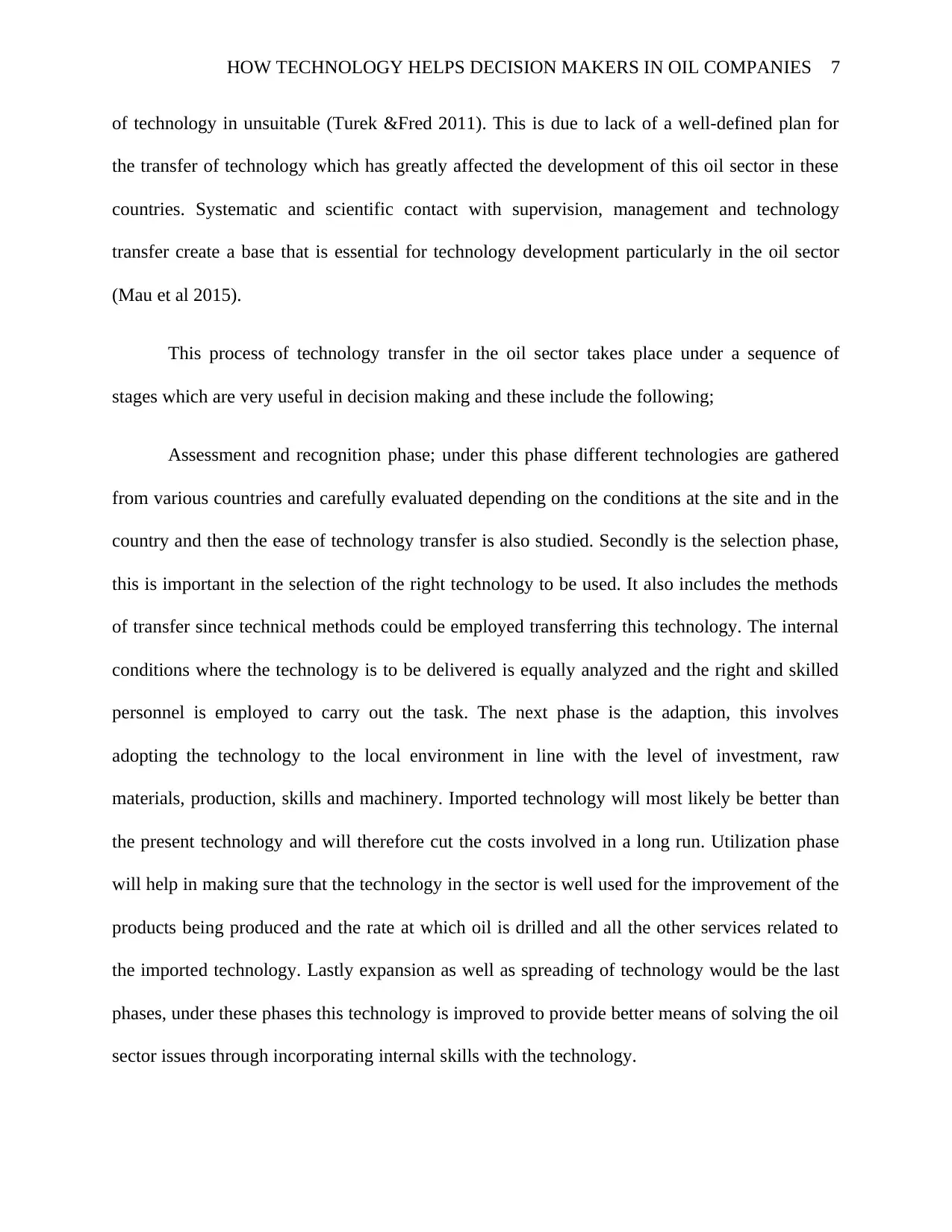
HOW TECHNOLOGY HELPS DECISION MAKERS IN OIL COMPANIES 7
of technology in unsuitable (Turek &Fred 2011). This is due to lack of a well-defined plan for
the transfer of technology which has greatly affected the development of this oil sector in these
countries. Systematic and scientific contact with supervision, management and technology
transfer create a base that is essential for technology development particularly in the oil sector
(Mau et al 2015).
This process of technology transfer in the oil sector takes place under a sequence of
stages which are very useful in decision making and these include the following;
Assessment and recognition phase; under this phase different technologies are gathered
from various countries and carefully evaluated depending on the conditions at the site and in the
country and then the ease of technology transfer is also studied. Secondly is the selection phase,
this is important in the selection of the right technology to be used. It also includes the methods
of transfer since technical methods could be employed transferring this technology. The internal
conditions where the technology is to be delivered is equally analyzed and the right and skilled
personnel is employed to carry out the task. The next phase is the adaption, this involves
adopting the technology to the local environment in line with the level of investment, raw
materials, production, skills and machinery. Imported technology will most likely be better than
the present technology and will therefore cut the costs involved in a long run. Utilization phase
will help in making sure that the technology in the sector is well used for the improvement of the
products being produced and the rate at which oil is drilled and all the other services related to
the imported technology. Lastly expansion as well as spreading of technology would be the last
phases, under these phases this technology is improved to provide better means of solving the oil
sector issues through incorporating internal skills with the technology.
of technology in unsuitable (Turek &Fred 2011). This is due to lack of a well-defined plan for
the transfer of technology which has greatly affected the development of this oil sector in these
countries. Systematic and scientific contact with supervision, management and technology
transfer create a base that is essential for technology development particularly in the oil sector
(Mau et al 2015).
This process of technology transfer in the oil sector takes place under a sequence of
stages which are very useful in decision making and these include the following;
Assessment and recognition phase; under this phase different technologies are gathered
from various countries and carefully evaluated depending on the conditions at the site and in the
country and then the ease of technology transfer is also studied. Secondly is the selection phase,
this is important in the selection of the right technology to be used. It also includes the methods
of transfer since technical methods could be employed transferring this technology. The internal
conditions where the technology is to be delivered is equally analyzed and the right and skilled
personnel is employed to carry out the task. The next phase is the adaption, this involves
adopting the technology to the local environment in line with the level of investment, raw
materials, production, skills and machinery. Imported technology will most likely be better than
the present technology and will therefore cut the costs involved in a long run. Utilization phase
will help in making sure that the technology in the sector is well used for the improvement of the
products being produced and the rate at which oil is drilled and all the other services related to
the imported technology. Lastly expansion as well as spreading of technology would be the last
phases, under these phases this technology is improved to provide better means of solving the oil
sector issues through incorporating internal skills with the technology.
Paraphrase This Document
Need a fresh take? Get an instant paraphrase of this document with our AI Paraphraser
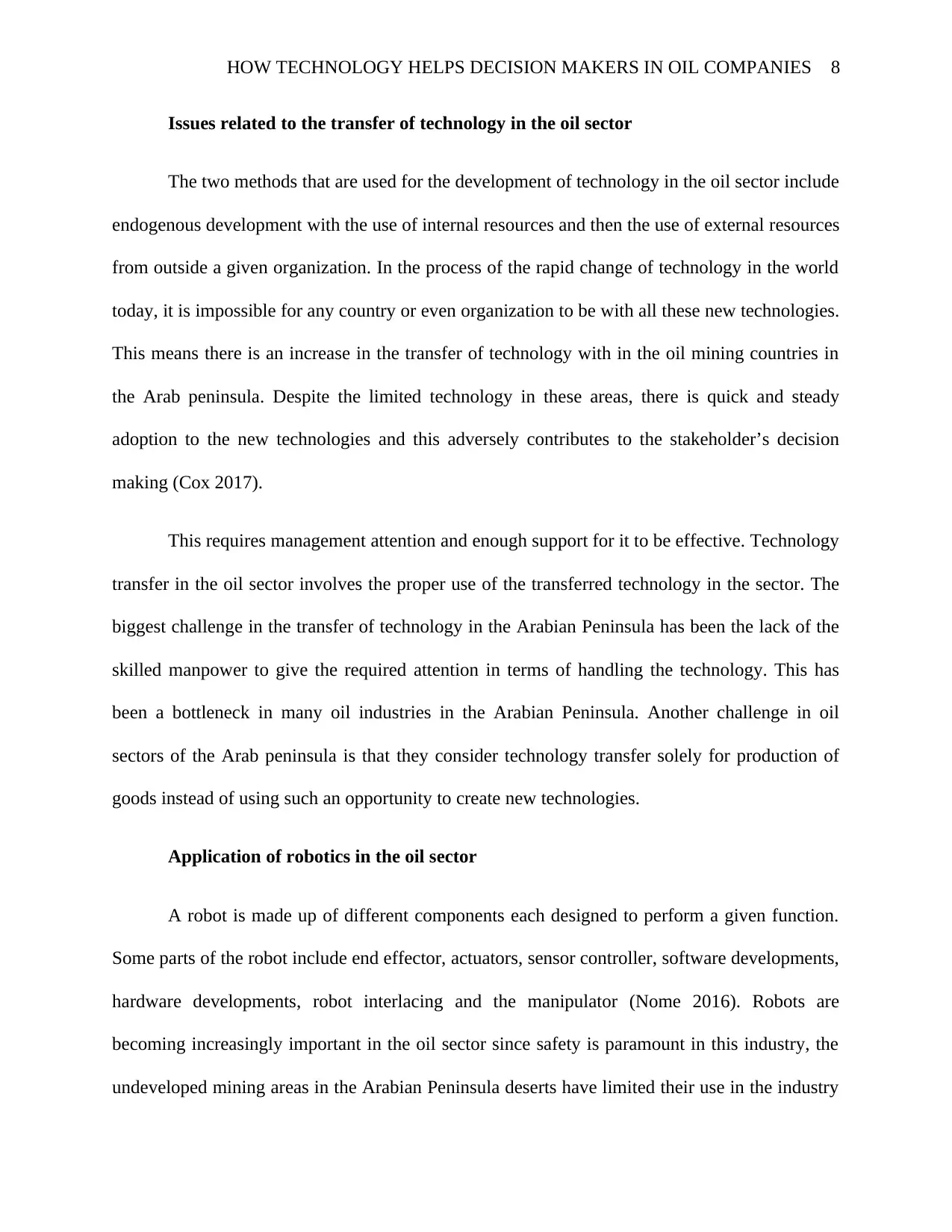
HOW TECHNOLOGY HELPS DECISION MAKERS IN OIL COMPANIES 8
Issues related to the transfer of technology in the oil sector
The two methods that are used for the development of technology in the oil sector include
endogenous development with the use of internal resources and then the use of external resources
from outside a given organization. In the process of the rapid change of technology in the world
today, it is impossible for any country or even organization to be with all these new technologies.
This means there is an increase in the transfer of technology with in the oil mining countries in
the Arab peninsula. Despite the limited technology in these areas, there is quick and steady
adoption to the new technologies and this adversely contributes to the stakeholder’s decision
making (Cox 2017).
This requires management attention and enough support for it to be effective. Technology
transfer in the oil sector involves the proper use of the transferred technology in the sector. The
biggest challenge in the transfer of technology in the Arabian Peninsula has been the lack of the
skilled manpower to give the required attention in terms of handling the technology. This has
been a bottleneck in many oil industries in the Arabian Peninsula. Another challenge in oil
sectors of the Arab peninsula is that they consider technology transfer solely for production of
goods instead of using such an opportunity to create new technologies.
Application of robotics in the oil sector
A robot is made up of different components each designed to perform a given function.
Some parts of the robot include end effector, actuators, sensor controller, software developments,
hardware developments, robot interlacing and the manipulator (Nome 2016). Robots are
becoming increasingly important in the oil sector since safety is paramount in this industry, the
undeveloped mining areas in the Arabian Peninsula deserts have limited their use in the industry
Issues related to the transfer of technology in the oil sector
The two methods that are used for the development of technology in the oil sector include
endogenous development with the use of internal resources and then the use of external resources
from outside a given organization. In the process of the rapid change of technology in the world
today, it is impossible for any country or even organization to be with all these new technologies.
This means there is an increase in the transfer of technology with in the oil mining countries in
the Arab peninsula. Despite the limited technology in these areas, there is quick and steady
adoption to the new technologies and this adversely contributes to the stakeholder’s decision
making (Cox 2017).
This requires management attention and enough support for it to be effective. Technology
transfer in the oil sector involves the proper use of the transferred technology in the sector. The
biggest challenge in the transfer of technology in the Arabian Peninsula has been the lack of the
skilled manpower to give the required attention in terms of handling the technology. This has
been a bottleneck in many oil industries in the Arabian Peninsula. Another challenge in oil
sectors of the Arab peninsula is that they consider technology transfer solely for production of
goods instead of using such an opportunity to create new technologies.
Application of robotics in the oil sector
A robot is made up of different components each designed to perform a given function.
Some parts of the robot include end effector, actuators, sensor controller, software developments,
hardware developments, robot interlacing and the manipulator (Nome 2016). Robots are
becoming increasingly important in the oil sector since safety is paramount in this industry, the
undeveloped mining areas in the Arabian Peninsula deserts have limited their use in the industry
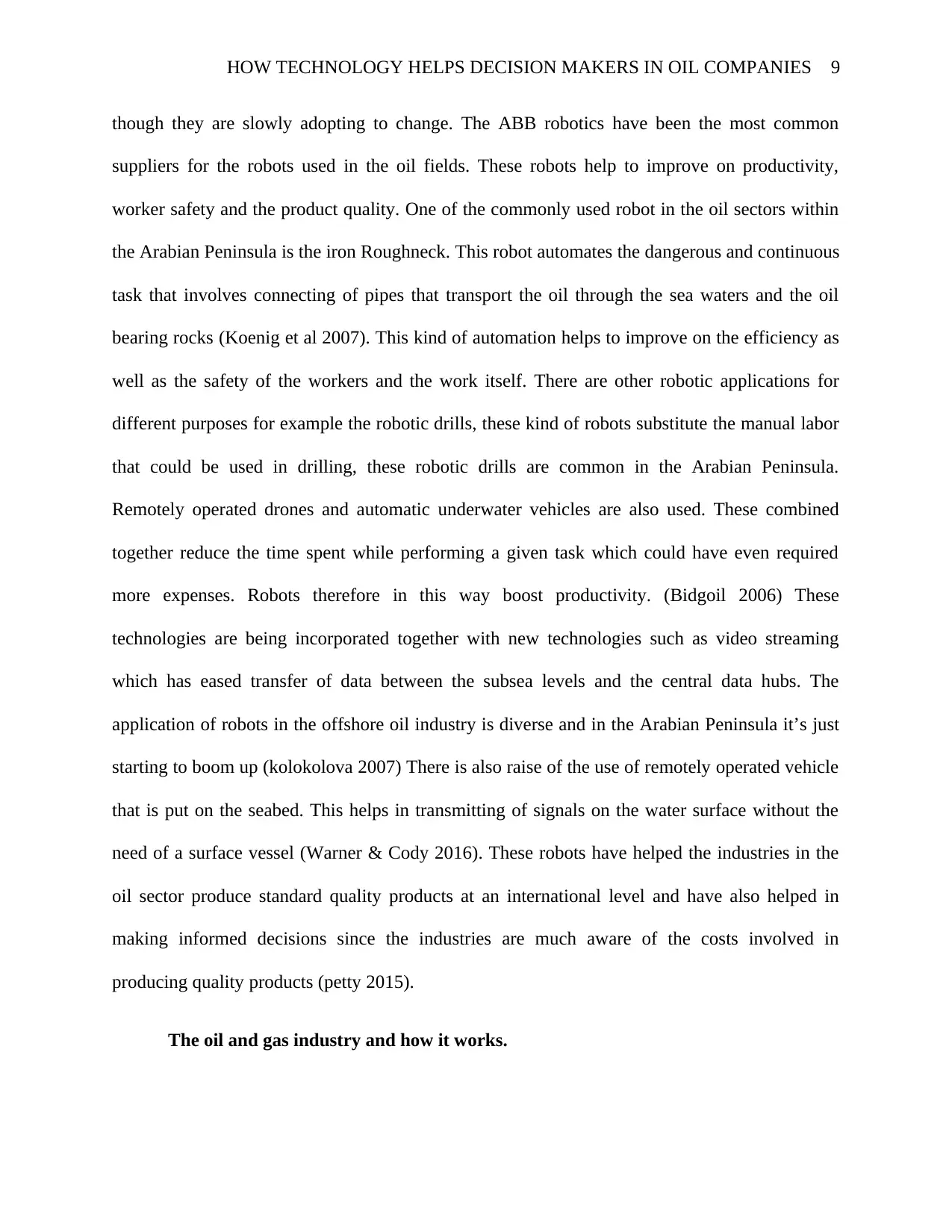
HOW TECHNOLOGY HELPS DECISION MAKERS IN OIL COMPANIES 9
though they are slowly adopting to change. The ABB robotics have been the most common
suppliers for the robots used in the oil fields. These robots help to improve on productivity,
worker safety and the product quality. One of the commonly used robot in the oil sectors within
the Arabian Peninsula is the iron Roughneck. This robot automates the dangerous and continuous
task that involves connecting of pipes that transport the oil through the sea waters and the oil
bearing rocks (Koenig et al 2007). This kind of automation helps to improve on the efficiency as
well as the safety of the workers and the work itself. There are other robotic applications for
different purposes for example the robotic drills, these kind of robots substitute the manual labor
that could be used in drilling, these robotic drills are common in the Arabian Peninsula.
Remotely operated drones and automatic underwater vehicles are also used. These combined
together reduce the time spent while performing a given task which could have even required
more expenses. Robots therefore in this way boost productivity. (Bidgoil 2006) These
technologies are being incorporated together with new technologies such as video streaming
which has eased transfer of data between the subsea levels and the central data hubs. The
application of robots in the offshore oil industry is diverse and in the Arabian Peninsula it’s just
starting to boom up (kolokolova 2007) There is also raise of the use of remotely operated vehicle
that is put on the seabed. This helps in transmitting of signals on the water surface without the
need of a surface vessel (Warner & Cody 2016). These robots have helped the industries in the
oil sector produce standard quality products at an international level and have also helped in
making informed decisions since the industries are much aware of the costs involved in
producing quality products (petty 2015).
The oil and gas industry and how it works.
though they are slowly adopting to change. The ABB robotics have been the most common
suppliers for the robots used in the oil fields. These robots help to improve on productivity,
worker safety and the product quality. One of the commonly used robot in the oil sectors within
the Arabian Peninsula is the iron Roughneck. This robot automates the dangerous and continuous
task that involves connecting of pipes that transport the oil through the sea waters and the oil
bearing rocks (Koenig et al 2007). This kind of automation helps to improve on the efficiency as
well as the safety of the workers and the work itself. There are other robotic applications for
different purposes for example the robotic drills, these kind of robots substitute the manual labor
that could be used in drilling, these robotic drills are common in the Arabian Peninsula.
Remotely operated drones and automatic underwater vehicles are also used. These combined
together reduce the time spent while performing a given task which could have even required
more expenses. Robots therefore in this way boost productivity. (Bidgoil 2006) These
technologies are being incorporated together with new technologies such as video streaming
which has eased transfer of data between the subsea levels and the central data hubs. The
application of robots in the offshore oil industry is diverse and in the Arabian Peninsula it’s just
starting to boom up (kolokolova 2007) There is also raise of the use of remotely operated vehicle
that is put on the seabed. This helps in transmitting of signals on the water surface without the
need of a surface vessel (Warner & Cody 2016). These robots have helped the industries in the
oil sector produce standard quality products at an international level and have also helped in
making informed decisions since the industries are much aware of the costs involved in
producing quality products (petty 2015).
The oil and gas industry and how it works.
⊘ This is a preview!⊘
Do you want full access?
Subscribe today to unlock all pages.

Trusted by 1+ million students worldwide
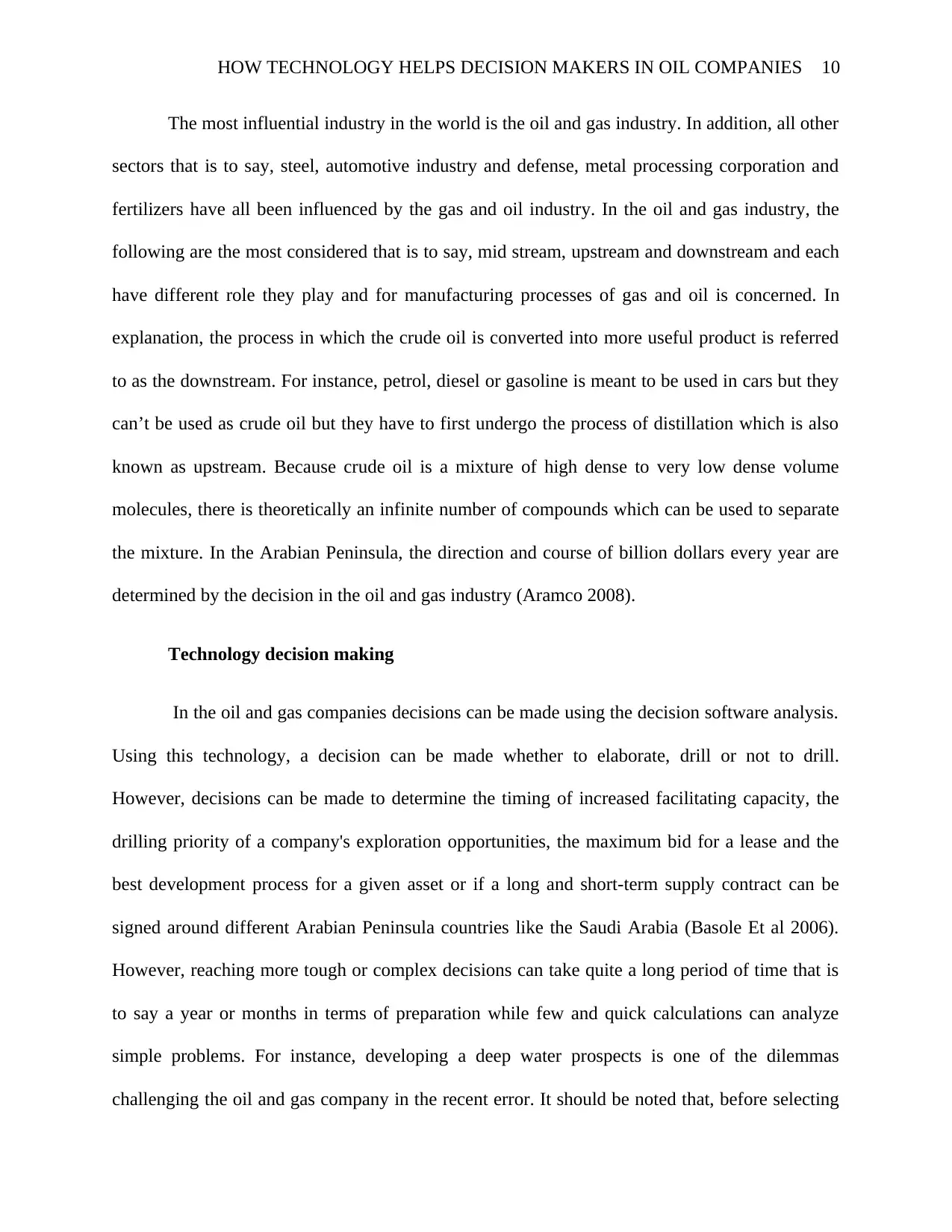
HOW TECHNOLOGY HELPS DECISION MAKERS IN OIL COMPANIES 10
The most influential industry in the world is the oil and gas industry. In addition, all other
sectors that is to say, steel, automotive industry and defense, metal processing corporation and
fertilizers have all been influenced by the gas and oil industry. In the oil and gas industry, the
following are the most considered that is to say, mid stream, upstream and downstream and each
have different role they play and for manufacturing processes of gas and oil is concerned. In
explanation, the process in which the crude oil is converted into more useful product is referred
to as the downstream. For instance, petrol, diesel or gasoline is meant to be used in cars but they
can’t be used as crude oil but they have to first undergo the process of distillation which is also
known as upstream. Because crude oil is a mixture of high dense to very low dense volume
molecules, there is theoretically an infinite number of compounds which can be used to separate
the mixture. In the Arabian Peninsula, the direction and course of billion dollars every year are
determined by the decision in the oil and gas industry (Aramco 2008).
Technology decision making
In the oil and gas companies decisions can be made using the decision software analysis.
Using this technology, a decision can be made whether to elaborate, drill or not to drill.
However, decisions can be made to determine the timing of increased facilitating capacity, the
drilling priority of a company's exploration opportunities, the maximum bid for a lease and the
best development process for a given asset or if a long and short-term supply contract can be
signed around different Arabian Peninsula countries like the Saudi Arabia (Basole Et al 2006).
However, reaching more tough or complex decisions can take quite a long period of time that is
to say a year or months in terms of preparation while few and quick calculations can analyze
simple problems. For instance, developing a deep water prospects is one of the dilemmas
challenging the oil and gas company in the recent error. It should be noted that, before selecting
The most influential industry in the world is the oil and gas industry. In addition, all other
sectors that is to say, steel, automotive industry and defense, metal processing corporation and
fertilizers have all been influenced by the gas and oil industry. In the oil and gas industry, the
following are the most considered that is to say, mid stream, upstream and downstream and each
have different role they play and for manufacturing processes of gas and oil is concerned. In
explanation, the process in which the crude oil is converted into more useful product is referred
to as the downstream. For instance, petrol, diesel or gasoline is meant to be used in cars but they
can’t be used as crude oil but they have to first undergo the process of distillation which is also
known as upstream. Because crude oil is a mixture of high dense to very low dense volume
molecules, there is theoretically an infinite number of compounds which can be used to separate
the mixture. In the Arabian Peninsula, the direction and course of billion dollars every year are
determined by the decision in the oil and gas industry (Aramco 2008).
Technology decision making
In the oil and gas companies decisions can be made using the decision software analysis.
Using this technology, a decision can be made whether to elaborate, drill or not to drill.
However, decisions can be made to determine the timing of increased facilitating capacity, the
drilling priority of a company's exploration opportunities, the maximum bid for a lease and the
best development process for a given asset or if a long and short-term supply contract can be
signed around different Arabian Peninsula countries like the Saudi Arabia (Basole Et al 2006).
However, reaching more tough or complex decisions can take quite a long period of time that is
to say a year or months in terms of preparation while few and quick calculations can analyze
simple problems. For instance, developing a deep water prospects is one of the dilemmas
challenging the oil and gas company in the recent error. It should be noted that, before selecting
Paraphrase This Document
Need a fresh take? Get an instant paraphrase of this document with our AI Paraphraser
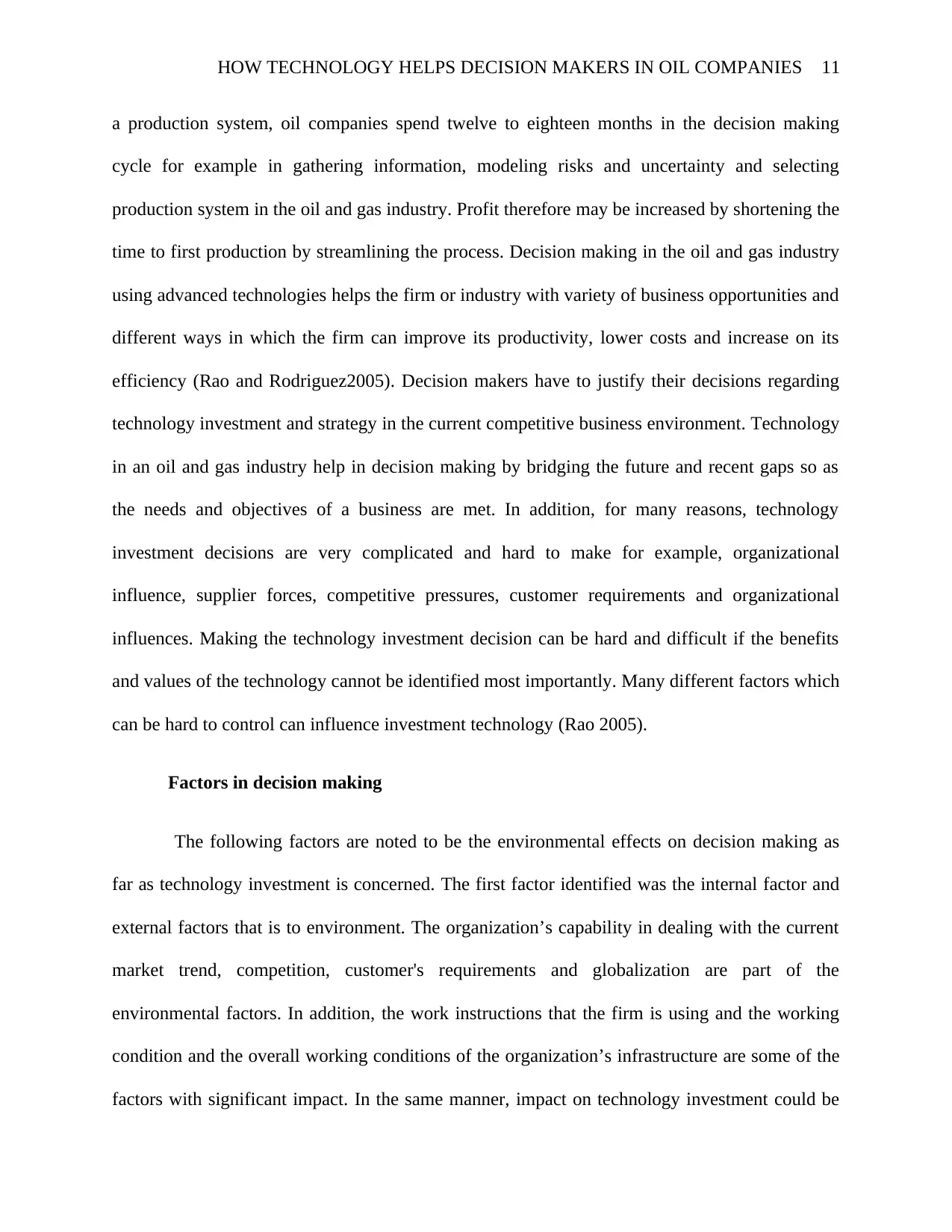
HOW TECHNOLOGY HELPS DECISION MAKERS IN OIL COMPANIES 11
a production system, oil companies spend twelve to eighteen months in the decision making
cycle for example in gathering information, modeling risks and uncertainty and selecting
production system in the oil and gas industry. Profit therefore may be increased by shortening the
time to first production by streamlining the process. Decision making in the oil and gas industry
using advanced technologies helps the firm or industry with variety of business opportunities and
different ways in which the firm can improve its productivity, lower costs and increase on its
efficiency (Rao and Rodriguez2005). Decision makers have to justify their decisions regarding
technology investment and strategy in the current competitive business environment. Technology
in an oil and gas industry help in decision making by bridging the future and recent gaps so as
the needs and objectives of a business are met. In addition, for many reasons, technology
investment decisions are very complicated and hard to make for example, organizational
influence, supplier forces, competitive pressures, customer requirements and organizational
influences. Making the technology investment decision can be hard and difficult if the benefits
and values of the technology cannot be identified most importantly. Many different factors which
can be hard to control can influence investment technology (Rao 2005).
Factors in decision making
The following factors are noted to be the environmental effects on decision making as
far as technology investment is concerned. The first factor identified was the internal factor and
external factors that is to environment. The organization’s capability in dealing with the current
market trend, competition, customer's requirements and globalization are part of the
environmental factors. In addition, the work instructions that the firm is using and the working
condition and the overall working conditions of the organization’s infrastructure are some of the
factors with significant impact. In the same manner, impact on technology investment could be
a production system, oil companies spend twelve to eighteen months in the decision making
cycle for example in gathering information, modeling risks and uncertainty and selecting
production system in the oil and gas industry. Profit therefore may be increased by shortening the
time to first production by streamlining the process. Decision making in the oil and gas industry
using advanced technologies helps the firm or industry with variety of business opportunities and
different ways in which the firm can improve its productivity, lower costs and increase on its
efficiency (Rao and Rodriguez2005). Decision makers have to justify their decisions regarding
technology investment and strategy in the current competitive business environment. Technology
in an oil and gas industry help in decision making by bridging the future and recent gaps so as
the needs and objectives of a business are met. In addition, for many reasons, technology
investment decisions are very complicated and hard to make for example, organizational
influence, supplier forces, competitive pressures, customer requirements and organizational
influences. Making the technology investment decision can be hard and difficult if the benefits
and values of the technology cannot be identified most importantly. Many different factors which
can be hard to control can influence investment technology (Rao 2005).
Factors in decision making
The following factors are noted to be the environmental effects on decision making as
far as technology investment is concerned. The first factor identified was the internal factor and
external factors that is to environment. The organization’s capability in dealing with the current
market trend, competition, customer's requirements and globalization are part of the
environmental factors. In addition, the work instructions that the firm is using and the working
condition and the overall working conditions of the organization’s infrastructure are some of the
factors with significant impact. In the same manner, impact on technology investment could be
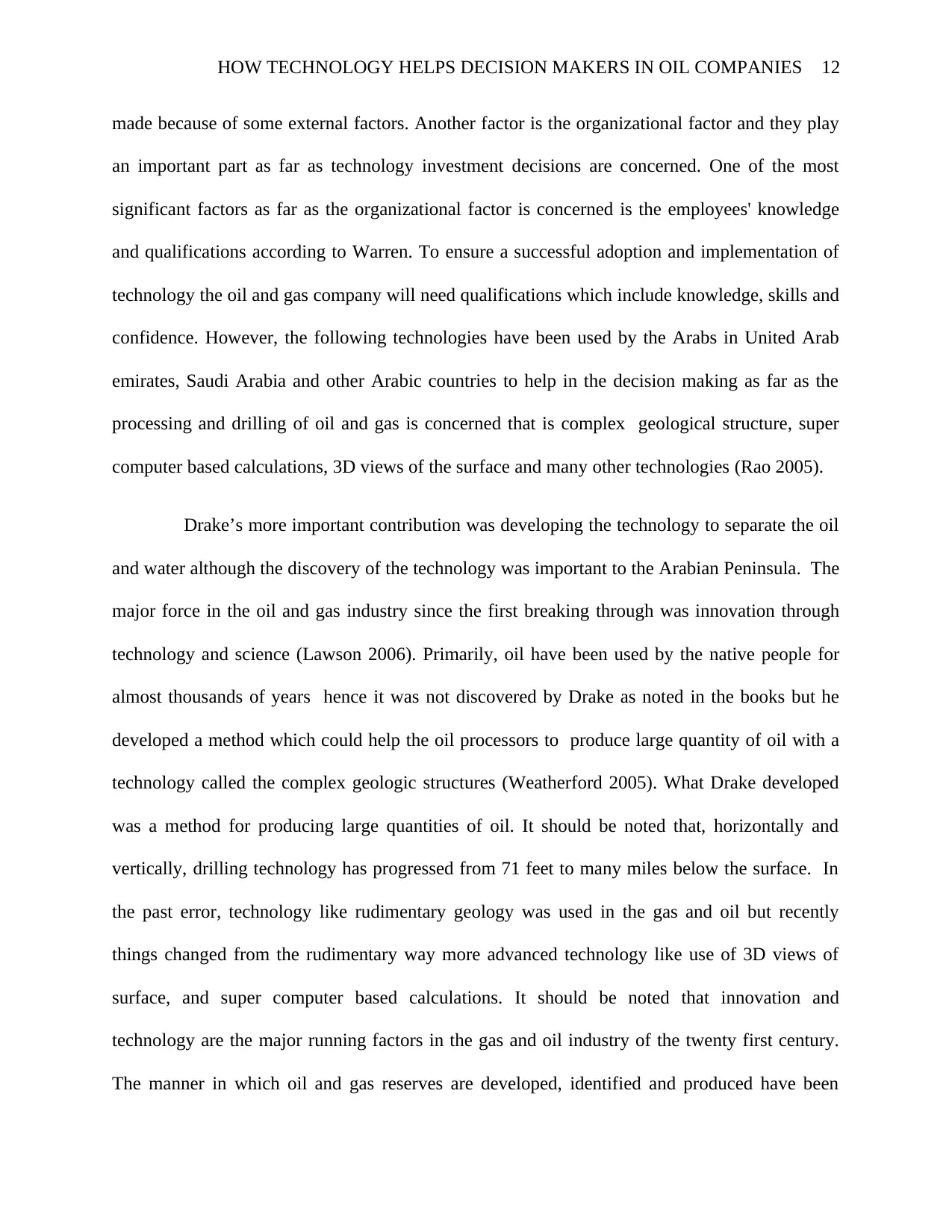
HOW TECHNOLOGY HELPS DECISION MAKERS IN OIL COMPANIES 12
made because of some external factors. Another factor is the organizational factor and they play
an important part as far as technology investment decisions are concerned. One of the most
significant factors as far as the organizational factor is concerned is the employees' knowledge
and qualifications according to Warren. To ensure a successful adoption and implementation of
technology the oil and gas company will need qualifications which include knowledge, skills and
confidence. However, the following technologies have been used by the Arabs in United Arab
emirates, Saudi Arabia and other Arabic countries to help in the decision making as far as the
processing and drilling of oil and gas is concerned that is complex geological structure, super
computer based calculations, 3D views of the surface and many other technologies (Rao 2005).
Drake’s more important contribution was developing the technology to separate the oil
and water although the discovery of the technology was important to the Arabian Peninsula. The
major force in the oil and gas industry since the first breaking through was innovation through
technology and science (Lawson 2006). Primarily, oil have been used by the native people for
almost thousands of years hence it was not discovered by Drake as noted in the books but he
developed a method which could help the oil processors to produce large quantity of oil with a
technology called the complex geologic structures (Weatherford 2005). What Drake developed
was a method for producing large quantities of oil. It should be noted that, horizontally and
vertically, drilling technology has progressed from 71 feet to many miles below the surface. In
the past error, technology like rudimentary geology was used in the gas and oil but recently
things changed from the rudimentary way more advanced technology like use of 3D views of
surface, and super computer based calculations. It should be noted that innovation and
technology are the major running factors in the gas and oil industry of the twenty first century.
The manner in which oil and gas reserves are developed, identified and produced have been
made because of some external factors. Another factor is the organizational factor and they play
an important part as far as technology investment decisions are concerned. One of the most
significant factors as far as the organizational factor is concerned is the employees' knowledge
and qualifications according to Warren. To ensure a successful adoption and implementation of
technology the oil and gas company will need qualifications which include knowledge, skills and
confidence. However, the following technologies have been used by the Arabs in United Arab
emirates, Saudi Arabia and other Arabic countries to help in the decision making as far as the
processing and drilling of oil and gas is concerned that is complex geological structure, super
computer based calculations, 3D views of the surface and many other technologies (Rao 2005).
Drake’s more important contribution was developing the technology to separate the oil
and water although the discovery of the technology was important to the Arabian Peninsula. The
major force in the oil and gas industry since the first breaking through was innovation through
technology and science (Lawson 2006). Primarily, oil have been used by the native people for
almost thousands of years hence it was not discovered by Drake as noted in the books but he
developed a method which could help the oil processors to produce large quantity of oil with a
technology called the complex geologic structures (Weatherford 2005). What Drake developed
was a method for producing large quantities of oil. It should be noted that, horizontally and
vertically, drilling technology has progressed from 71 feet to many miles below the surface. In
the past error, technology like rudimentary geology was used in the gas and oil but recently
things changed from the rudimentary way more advanced technology like use of 3D views of
surface, and super computer based calculations. It should be noted that innovation and
technology are the major running factors in the gas and oil industry of the twenty first century.
The manner in which oil and gas reserves are developed, identified and produced have been
⊘ This is a preview!⊘
Do you want full access?
Subscribe today to unlock all pages.

Trusted by 1+ million students worldwide
1 out of 26
Related Documents
Your All-in-One AI-Powered Toolkit for Academic Success.
+13062052269
info@desklib.com
Available 24*7 on WhatsApp / Email
![[object Object]](/_next/static/media/star-bottom.7253800d.svg)
Unlock your academic potential
Copyright © 2020–2025 A2Z Services. All Rights Reserved. Developed and managed by ZUCOL.




